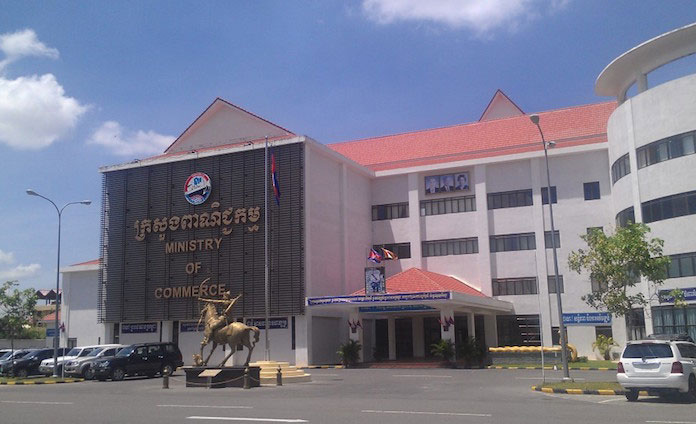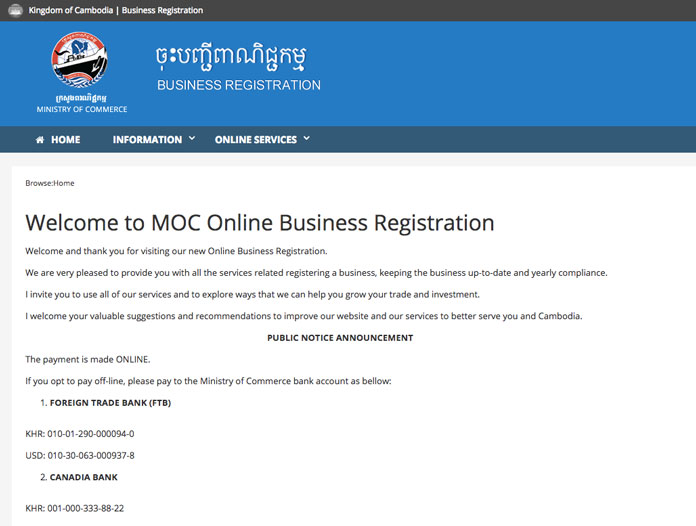Incorporating Your Business In Cambodia In 2017

The way businesses are legally incorporated in the Kingdom has changed drastically over the last few years. The launch of the Ministry of Commerce’s online company registration system in December 2015 was one of the biggest milestones for the country in this regard.
This and other web-based systems introduced to facilitate the incorporation of businesses have almost as many detractors as they do advocates, but all things considered, one thing is clear: officially registering a business in 2017 is a much different affair than it was previously. B2B Cambodia walks you through the new process with the help of experts in company incorporation.
The MOC
When incorporating a company in Cambodia, the new legal entity must register with three governmental bodies: the Ministry of Commerce (MOC), the General Department of Taxation (GDT), and the Ministry of Labor and Vocational Training (MLVT). After registering your company with the MOC, you will receive its constitutive documents, which include the certificate of incorporation, the Articles of Association, and the business license.

To register with the MOC, you will be required to visit the Ministry and present the following documents:
- Register of shareholders (including their percentage of equity)
- Register of directors (if different from shareholders)
- Business’ physical address
- Original lease agreement
- Copy of the property tax receipt – you need to obtain this document from the owner of the property where your business is located
- Bank confirmation letter – this document may be presented after you have obtained the company's constitutive documents
With regards to the company’s directors and shareholders, you will also need to present the following information and documents:
- Residential letter of chairman or country representative stamped by the local sangkat (commune). To obtain the residency letter, the chairman or country representative needs to go to the local sangkat with their residential lease agreement. If they own the property they reside in, they need to present the corresponding property deed. Securing a residence letter from the sangkat costs between $30-50
- Copy of passport – one for each director and shareholder
- Photos – for each director and shareholder, bring six 4cm x 6cm photos and six 3.5cm x 4.5cm photos
- Other personal information – you will need to supply the home address, email and telephone number of each director and shareholder
Finally, you will also need to have the following information handy:
- Name of the company – do your homework before stepping into the MOC. Make sure that you choose a name that isn’t already in use by any other enterprise. If any other company in the world is using that name, the MOC will reject it: keep in mind that a $15 fee applies every time the MOC checks a new name. The cost for processing the application for a name is $700. If you are using an agent, they will ask you to send in three different names rated according to your preference
- Structure of the company (single member, limited liability, partnership, subsidiary, representative office, etc)
- Startup capital (the minimum capital to form a company is $1,300)
- Type of business (business activity)
Additionally, if you are forming a branch or a subsidiary using the parent company as the shareholder (in whole or part), you will need to provide the parent company’s certificate of incorporation and Articles of Association (three copies), certified by a lawyer in the country of the parent company. You will also need a power of attorney issued by the chairman of the parent company or a board resolution from such company allowing the country representative to figure in the tax patent as well as figuring as a nominee in the company’s bank accounts. The process can now be carried out on the internet. For more on this, read our article on the new online business registration system.

The GDT
Within 15 calendar days of having registered with the MOC, the new enterprise must register with the GDT. Registering as a taxpayer will cost you $500 and $650, for a half-year and a full-year respectively. At the GDT, you will obtain the tax patent and the VAT certificate of the new company. To do so, you will need to complete an application for tax registration. In addition, the chairman or country representative will be required to visit the tax authority’s premises to have their picture and fingerprints taken. If all is in order, it will take the GDT between two and four weeks to issue the tax patent and VAT certificate.
The MLVT
The MLVT registers the company under the Labour Law, provides workbooks for Khmer employees and work permits and employment cards for foreign workers. If the new company has more than eight employees, they must be registered under the National Social Security Fund. The process of registering with the MLVT have recently changed, and it can now be done online. However, the details of how the new process works remain unclear.
Need some help?
Despite the fact that company owners can now register their companies online without the help of a middleman, our contributors insist that resorting to an agent can save you time and money. “The online system, as evidenced by sequential deadline extensions for the online registration process, remains much more complex than using an agent. It has proven to be slower and cumbersome as a whole,” says Anthony Galliano, chairman of Cambodia Investment Management. Agents are often able to access MOC staff to expedite the process. Users of the MOC’s online system report it can take weeks to get a corporate name approved. An agent can potentially do it within the day.
Finally, don’t forget that registration with the MOC is only step one. Even if you successfully manage to register your company through MOC’s online registration system, you still have to deal with the GDT and the MLVT, which are completely independent processes. Remember that the GDT part cannot be done online, and while the MLVT does offer the option to carry out the process through the internet, many users report having a challenging experience dealing with the website.